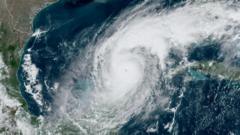The upcoming Atlantic hurricane season is on track to be more active than usual, according to predictions from the National Oceanic and Atmospheric Administration (NOAA). With forecasts indicating between six to ten hurricanes, experts are concerned that recent budget cuts to NOAA could compromise the nation's ability to adequately track and prepare for these potentially devastating storms.
From June to November, NOAA projects that the Atlantic region, including the Caribbean Sea and Gulf of Mexico, will see a higher-than-average incidence of tropical storms. The reasoning behind this prediction ties to rising sea temperatures, exacerbated by climate change, which serve as fuel for hurricane formation, along with favorable atmospheric conditions.
Despite a less active hurricane season last year when 11 hurricanes formed, ongoing climate changes are expected to increase the intensity of storms, potentially leading to more severe weather patterns. As atmospheres warm, the potential for hurricanes developing into stronger storms capable of causing significant coastline flooding rises.
Two key factors underline this year's forecast. One is the higher-than-average sea surface temperatures across the tropical Atlantic, which, while not at extreme levels compared to last year, still present an encouraging environment for storms. Additionally, predictions indicate that the El Niño pattern – traditionally a deterrent to Atlantic storm development – is likely absent this year. Instead, neutral or weak La Niña conditions are predicted, which generally favor the formation of hurricanes.
However, NOAA's grim setup comes alongside reports of staffing shortages following widespread layoffs enacted by the Trump administration, with claims that these downsizings would critically impact the National Weather Service. Scientists express concern that the current workforce may be ill-prepared to manage forecasting efforts, which could lead to delays and inaccuracies during critical weather events.
Zack Labe, a climate scientist affected by the layoffs, noted that the remaining staff members are working tirelessly, but the reduction in personnel could lead to potential forecasting errors or missed opportunities for critical early warnings. Concerns have escalated regarding the operational integrity of various NOAA offices, particularly given the reported vacancy of essential management roles needed for effective response in hurricane-prone areas, like Texas.
The need for adequate staffing is especially pronounced as hurricane forecasts become increasingly dependent on expansive data gathering, essential for developing accurate models of storm behavior. Meteorologists warn that less observational data could compromise the precision of forecasts, impacting not just the U.S. but global weather forecasting capabilities over time.
As the 2025 hurricane season looms closer, climate scientists emphasize the urgency of addressing NOAA’s staffing and funding challenges to ensure public safety and preparedness. Despite NOAA's assurances regarding its capabilities, experts call for restoration of prior funding levels to safeguard against potential disastrous consequences during this intense hurricane season ahead.

















